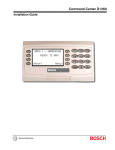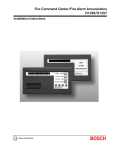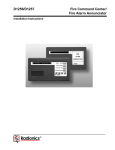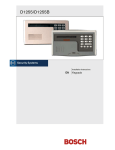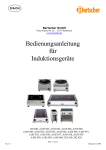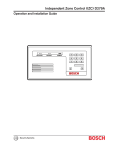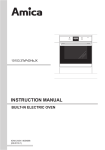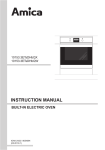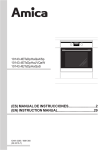Download Myalarm D420 Specifications
Transcript
C-0636-020-01 0 A R I D 0 N I C S D636A Command Center Specifications Sheet Features . Displays complete system status in English text Used with the D4112 and D6112 Control/ Communicators l . Programmable custom text for each zone . Easy to understand backlit LCD Display . Illuminated touchpad . Red Armed Status LED . Programmable “idle display” text l User friendly system status sounder . Initiate local system test and perimeter Watch from the keypad l l . The D636A Command Center does more than just arm and disarm the D4112/D6112 security system. When you use the Command Bar with one or two other keys, the D636 gives you control over the entire security system. Three programmable onetouch function keys . . Command Control The D4112 and D6112 Control/ Communicators can be programmed for a wide variety of command functions executed from the D636A Command Center. Multiple arming options and special alarm options Slim-line designer styling compliments any decor. Programmable Function Keys Three expansion zones The D636A has three function keys, and when used with the D6112, can be programmed to perform most system command functions (other than arming commands) with the touch of one key. When used with Four-wire connection to the control/communicator 7 5 - 0 5 5 0 6 - 0 0 0 - C 6/90 - the D4112, the function keys are preprogrammed. Function key “A” is Command 44 (local system test), function key “B” is Command 47 (reset detectors), and function key “C” is Command 5 (passcode change). English Language Display The D636A display consists of 2 lines, each containing 16 characters of English-language text. The first line is the idle text display. This line can be programmed to display your company name when the Command Center is in the idle state. The second line displays all system events, giving the end user instant identification of system status. No guesswork is involved. Programmable displays for each protective zone give your company’s installations that special customized touch. Q 1989-1990 Radionics, Inc. C-0636-020-020 Zone Expansion The D636A provides the security system with three additional end-ofline resistor supervised hardwire protective zones (for use with the D6112 only). The protective zones report to the D6112 individually, and can be controlled from any Command Center assigned to the same account as the zone. User Programmable Passcodes Code Programmer. Basic programming for the security system is accomplished using the 6112:MAIN or D4 112:MAIN Product Handler. Custom Text for the D636A is programmed with the D636 Keypad Handler. The D636 Keypad Handler allows you to program one line of custom text for each zone and one line of custom text for the “idle display.” Installation The user can change existing passcodes directly from the Command Center. Programming All programming for the D636A is accomplished with the D5100 Bar Installing the D636A is simple, quick, and cost effective. A four-conductor cable is all that is required to connect the D636A Command Center to the control panel. The expansion zones are fully supervised using three 1 KC! end-ofline resistors (included). Customize your Installation with these D636A Accessories-D54B Brass Faceplate: Comes with a backbox for flushmount applications. D54C Stainless Steel Faceplate: C o m e s w i t h a backbox for flushmount applications. D55 Desk Stand: Portable stand made of attractive smoked Plexiglass holds the D636A at a comfortable angle for reading the display and using the keys. D56 Conduit Box: A surface mount backbox for applications requiring conduit protection for D636A wiring. Specifications Power: Nominal 12 VDC supplied by the Control/Communicator auxiliary power supply Current: Idle: 27mA, keypad unlit, disarmed. 75mA, keypad lit, armed Maximum: 104mA, keypad lit and warning tone “on” Wiring : A 22 gauge, 4-conductor cable supplies data-in, data-out, +12 VDC, and common. A total maximum of 4 serial devices (D620, D630, D626, D636A or D640) may be connected to the D6112 Control/Communicator. A total maximum of 2 serial devices may be connected to the D4112. Dimensions: Height: 4.56”, Width: 8.15”, Depth: 0.816” Color: Warm gray Display: Two-line 16-character Liquid Crystal Display (LCD). 15 characters of programmable custom text. Backlit during entry delay, alarms, and when a Command Center digit is depressed. Keypad: Backlighting of the keypad can be selected with a jumper: Normal operation: Backlit during entry delay, alarms, and when a Command Center digit is depressed. Jumper cut: Keypad backlighting remains lit continuously. Environment: Operating Temp: 0” to 50°C (32” to 122°F) Non-condensing relative humidity: 5 to 85% @ 30°C (86°F) Radionics” 1800 ABBOTT ST., P.O. BOX 80012, SALINAS, CA 93912-0012 C-0636-030-01 0 R A D I 0 N I S C D636A Command Center Installation Instructions 1. General Description ENGLISH TEXT DISPLAY ARMED STATUS INDICATOR DIGITAL KEYPAD The D636A Command Center is a low profile surface mount, four-wire unit designedforuse with the Radionics D4112 and D6112 Control/Communicators. The D636A features an illuminated keypad, a backlit, 2-line (16 characters each) English text LCD display, an armed status indicator, three programmable function keys and a built-in sounder that emits several distinct tones. All D636A power and data requirements are supplied by the Control/Communicator via a simple four-wire connection. Up to four D636A Command Centers can be installed in one D6112 system and up to two can be installed in one D4112 system. Custom text is programmed into the D636A Command Center using the D5100 Bar Code Programmer loaded with the D636 Keypad Handler. 2. The Display The D636A Command Center continuously displays the latest status conditions of the security system using words, numbers, and symbols in its display. When a series of events occur that affect the system, the D636A displays each event by priority, for example, alarms are displayed before faults. The LCD display is illuminated if any key on the Command Center is pressed and remains lit for approximately 18 seconds. The display lights when there is alarm memory and will remain lit until the memory is cleared with a COMMAND 4 3. The Command Center Digital Keypad__ The D636A has a COMMAND bar, an ENT (ENTER) key, three programmable function keys labeled A, B, and C, and number keys from 0 to 9. These fifteen keys are used to enter command functions and personal passcodes into the Control/Communicator. Under normal operations the keypad is continuously backlit. The D636A does give you the option of having the keypad time-out under the same conditions as the LCD display. For backlight time-out operations on the keypad, cut jumper W4. 74-05475-000-c 5/90 COMMAND BAR ENTER KEY SOUNDER FUNCTION KEYS Figure 1: D636A COMMAND CENTER 3.1 COMMAND Bar: The Command bar is used to initiate standard one- or two-digit command functions. 3.2 ENT Key: When a passcode is completed, the ENT key must be pressed to enter the passcode. If the ENT key is not pressed within five seconds the passcode is ignored by the Control/Communicator. The ENT key is not required to enter COMMAND bar functions. The Control/Communicators have a time window for accepting key entries. After one key is pressed, the next key must be pressed within five seconds. After five seconds have expired from the last key entry, the entire entry is cleared and must be restarted. 3.3 Function Keys: Each function key can be programmed to perform a specific command function of the D6112 Control/Communicator. When used with the D4112, the D636A function keys are preprogrammed. Function key “A” is Command 44 (local system test), function key “B” is Command 47 (reset detectors), and function key “C” is Command 5 (passcode change). These function keys enable the user to press one button to perform command functions instead of memorizing the two digit command. For complete details concerning the programming of the function keys when using the D6112, see the 6112:MAIN Program Entry Guide. When using a function key to initiate a command, the command is not shown on the D636A display as described in the User’s Guide. In order to provide displays for each command asdescribed in the User’s Guide, the command must be initiated using the Command bar. D636A Operation/Installation Instructions Page 1 0 1989-1990 Radionics, Inc. C-0636-030-020 4. Response Tones All command centers contain a sounder used to annunciate several system conditions and account conditions. The response tones for the D636A are as follows: Entrance Warning - The command center emits a pulsating beep during the entry delay period to remind the user to disarm the security system. This is a programmable function of the D4112 and D6112. Keystroke Entry - As each key is touched the command center emits a short beep to indicate that the entry has been stored in the command center buffer. Faulted Zone Protest - The system may be programmed to sound the account command center buzzer for two seconds after an arming attempt has been made, to indicate that a zone is faulted. 7. D636/D636A Command Centers (Old and New Versions) The only difference between the D636 and the D636A is the addition of the keypad backlight jumper (W4) which is present on the D636A Command Center (refer to Figure 3) and a product ID label on the back of the command center base. These are the only visual indications between the two assemblies. Figure 3 also illustrates the difference between a new D636A and a D636 converted to a D636A. When the backlight jumper (W4) is cut, the D636A digital keypad backlighting will only illuminate when a digit is pressed, when the alarm system is in the entry delay mode, during alarm memory, or if a digit is pressed. When the jumper is left intact, the D636A digital keypad is continuously illuminated. Watch Tone - The command center sounder emits a short beep when a perimeter zone is faulted during the perimeter watch mode. Service Tone - Some zones may be programmed to sound a service tone when they are faulted. To silence the sounder enter your passcode, plus ENTER, or enter COMMAND 4. NOTE: Some zones, such as fire zones, may be programmed so that the sounder cannot be silenced until the zone fault is corrected (see the D6112: MAIN Program Entry Guide or D4172 installation and Programming Manual). Telephone Trouble - In a reporting system when the phone line is disconnected or the system is unable to make contact with the Central Station receiver, the Command Center beeps until the situation is corrected, or a personal passcode or COMMAND 4 is entered. 5. Figure 2: D636 CIRCUIT BOARD Zone Annunciation The D636A Command Center can display information for up to sixteen protective zones. 6. Command Center Sounder Disable _ To permanently disable the sounder; remove all power from the Command Center, cut the leads on resistor R36 (see Figure 2), and remove this component. R 5 6 RESISTOR W 4 JUMPER D636 AFTER CONVERSION W4 JUMPER R56 RESISTOR NEW D636A COMMAND CENTERS Figure 3: D636A CHANGES NOTE: For U.L. installations, the sounder on at least one Command Center in the D4112/D6112 system must remain connected. 74-05475-000-c 5/90 D636A Operation/Installation instructions Page 2 Q 1989-1990 Radionics, Inc. _ C-0636-030-040 D636A COMMAND CENTER BLACK I RED Figure 5: INSTALLING THE D636A COMMAND CENTER TO THE D6112 D636A COMMAND CENTER & / WHITE WHITE RED BLACK Figure 6: INSTALLING THE D636A COMMAND CENTER TO THE D4112 9.1 Remove the Front Cover - Remove the front cover from the enclosure base. Use a small flatbladed screwdriver to gently push the two bottom cover tabs back. As the tabs are pushed back, lift the bottom of the cover away from the base. Remove the cover. 9.2 Wire the D636A - The total cable length used to connect the command centers to the Control/ Communicator can run no longer than 1000 feet when using 22 AWG. The wire run between serial devices (D420, D620, D626, D630, D636A or D640) can be no more than 300 feet. Route the four color-coded flying leads through the wiring opening in the back of the enclosure base and plug intotheserialdatawirtngconnectorinthecommand center. Figures 5 and 6 show typical installations using one D636A command center. For installing more than one device refer to the D6112 Operation and installation Manual (74-04366-000) or the D4112 Installation and Programming Manual (7405365-000). D636A Operation/Installation Instructions 74-05475-000-c 4/90 Page 4 Q 1999-l 990 Radionics, Inc. C-0636-030-050 9.3 Mount the Enclosure Base- Place the enclosure base on the wall in the desired location. Use a centerpunchorapenciltomarkthelocationsofthe mounting holes. (The enclosure base can be mounted to a single-gang wall box if desired. Two mounting screw holes on the base are positioned for standard single-gang compatibility.) Secure the enclosure base to the wall or gang box. 9.4 Adjust the Display Contrast - Adjust the Potentiometer (see Figure 2) for optimum display contrast. 9.5 custom text programming should be completed before replacing the front cover. Custom text programming can be found in Section 10. 9.6 Replace the Front Cover - Align the top two tabs of the enclosure cover with the top two tab slots in the enclosure base. Slide the top of the cover into the base. Gently push the bottom of the cover down on the base until it snaps into place. 9.7 Adjust the Keys - Push each key on the keypad towards the top of the enclosure to ensure proper mating with the openings in the top cover. Program the D636A Command Center - Since the programming jack is located inside the D636A, 10. Custom Text Programming for the D636 The D636A custom text for each zone is programmed using the D5100 Programmer loaded with the D636A Keypad Handler (74-05569-000). (When using the D5100 Programmer, refer to the D5100 Operation and Installation manual #74-02521-000.) There are two types of Custom Text that can be programmed, Custom Text for each zone, and Custom Text for the Idle display. Each Custom Text display can be up to 15 characters long. Standard text (which is not programmable) appears on the first line of the D636A Display and Custom Text appears on the second line. Below is an example of both types of text. Idle Display 10.1 Zone Display Disable the Control/Communicator by attaching a Jumper from the Reset Pin to common until programming is completed. This is done to prevent the Control/Communicator from reporting to the Central Station while the D636A is being programmed. ZONE JUMPERS POWER DATA PROGRAMMING DIP SWITCH D636 Display: Display alternates between idle display. If the display is not on, remove the jumper and try the procedure again. DATA PROGRAMMER L CONNECTION NOTE: While it is disabled, verify the Control/ Communicator is still supplying power to the D636A. 10.2 Switch Power and both Data switches on the D636A Programming Dip Switch (see Figure 7), to the OFF position. Figure 7: PROGRAMMING DIP SWITCH 10.3 Connect the D5100 to the D636A Programmer Connection (see Figure 3 and 7) using the D5106 Programmer Interface Cord or the D5103A Programmer Cord. 74-05475ODD-C 4/90 D636A Operation/Installation Instructions Page 5 Q 1989-1990 Radionics, Inc. C-0636-030-060 10.4 Access the Handier as shown in Figure 8. a. Starting at OmegaWand 2.6, scan the ADVANCE bar code until 636 Keypad ##.## appears. Scan ENTER. b. 636M: New File appears, scan ENTER. C. When 636M : appears, enter a file name. ADVANCE 6 3 6 Other Handheld New Flh ADVANCE Other 636 Files 1 ENTER 4 Enter New File Name 636M: ADVANCE ENTER Zone 1 Display ADVANCE ENTER Enter the Custom Text for each zone , ADVANCE 7 ENTER Zone 2 Display ADVANCE ENTER l ADVANCE g. The next Zone # Display will appear. Follow steps e - g until custom text has been assigned to each Zone and to the Custom Text display. h. Save your program if necessary. The same program must be loaded into each D636A on the same account. ENTER Zone 16 Display ADVANCE ENTER , ADVANCE ENTER Custom Text ADVANCE ENTER i;] A D V A N C E / E N T E R 10.5 On the D636A, press keys 4 and 6 simultaneously and hold while switching Power on the Programming Dip Switch to the ON position. PROGRAMMING ADVANCE ENTER d. Scan ENTER to access Zone 1 Display. e. Scan ENTER or ADVANCE and the Zone 1 custom text display appears (> ). f. Enter up to 15 characters of Custom text for Zone 1, centerthe text in the display, and stroke ENTER. D636A Display: 636 Keypad UY Enter the Custom Text for the Idle display. Figure 8: D636A Programming I 12. System Trouble Report Codes (COMMAND 42 and COMMAND 40)_ Release the keys. 10.6 Load the 638 Keypad program from the D5100 to the D636A Command Center by stroking LOAD PANEL on the D5100. D636A Display: L NOTE: This display also appears when Copying the program from the D636A to the D5100 Bar Code Programmer. 10.7 Disconnect the D5100 Prgrammer from the D636A and turn the Data switches to the ON position. 10.8 Remove the Disable Jumper from the Control/ Communicator. 10.9 Test your D636A Command Center to confirm the Custom text programming. 11. Programming the D4112 and D6112 _ The device model programming (6112=4.2 D I Model and D4112= 1 Account, Device 1 Type) for the D636A is programmed as a 3, the same as for a 0630 Command Center. 74-05475-000-c 4/90 Typically, when a system trouble occurs, the trouble buzzer of the command center sounds. When the subscriber reports this condition to the Central Station operator, the subscriber may be instructed to enter a COMMAND 42 at the D636A (See 5.10 C m d 4 2 , in the D6112 Program Entry Guide #74-04367-000, and Sys Test/Reset, Cmd42DiagRpt, in the D4 112 Installation and Programming Manual #74-05365-000). If pulsed format is transmitted, only the trouble report code is sent to the central station. If there are no system troubles present when COMMAND 42 is entered, a restoral report is transmitted. If the communicator transmits in BFSK format, a trouble report code and “STATUS REPORT” is sent to the central station. If there are no system troubles, a restoral report and “STATUS REPORT” is transmitted. If the Modem II format is used by the communicator, a trouble report code and “DIAG REPORT” is sent to the central station. If there are no system troubles, a “DIAG REPORT” is transmitted. Keying COMMAND 40 or 42 at the D636A Command Center displays a trouble report. If applicable, a second trouble report can be displayed by keying in the command again. Maximum number of trouble reports that can be held in the Command Center’s trouble memory is two. D636A Operation/installation Instructions Page 6 Q 1989-1990 Radionics, Inc. C-0636-030-080 14. D636A Command Center Specifications Operating Voltage: Nominal 12 VDC supplied by the Control/ Communicator auxiliary power supply. Current Requirements: Jumper Intact: 34mA keypad on, LCD off, disarmed. Idle: 40mA keypad off, LCD off, LED on, armed. 75mA keypad on, LCD on, LED on, armed, alarm memory Maximum: 96mA keypad on, LCD on, LED on, tone on. Jumper Cut: Idle: 24mA keypad off, LCD off, disarmed. 30mA keypad off, LCD off, LED on, armed. Enclosure Dimensions: Height 4.56”, Length 8.15”, Depth .816” Color: Warm gray. Radionics” Operating Temperature: 0 to 50 “C (32 to 122 “F) Non-condensing Relative Humidity: 5 to 85% at 30 “C (86 “F) Command Center Wiring: Four-conductor cable supplies data-in, data-out, positive voltage, and common. Zone Wiring: Three two-wire loops (for use with the D6112 only). Each loop uses a 1000 ohm end-of-line resistor for zone supervision. Compatible with sensing devices having normally open dry contact output (wired in parallel) and/or normally closed dry contact output (wired in series). Display: Armed Status Indicator: Annunciates account armed status by indicating if the security system is armed. LCD Display: Two-line 16-character, Liquid Crystal Display (LCD). 15 characters of programmable custom text. Backlit during entry delay, alarms, and when a Command Center digit is pressed. 1800 ABBOTT ST., P.O. BOX 80012, SALINAS, CA 93912-0012 TECHNICAL SUPPORT: (800) 538-5807










